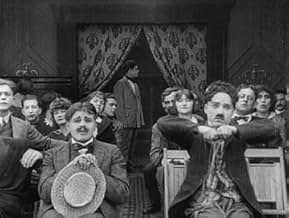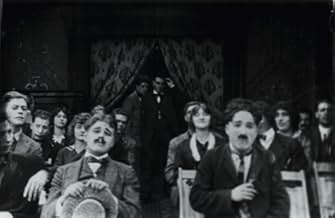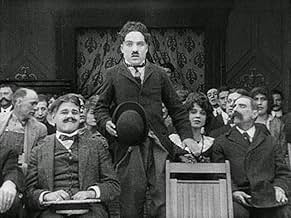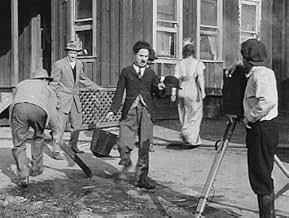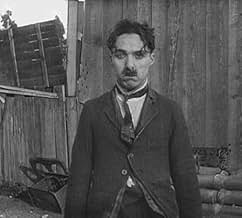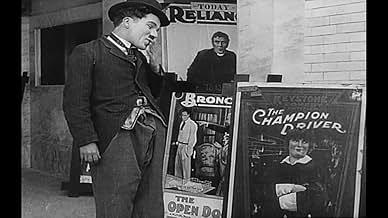IMDb RATING
5.6/10
1.8K
YOUR RATING
Charlie attempts to meet his favorite movie actress at the Keystone Studio, but does not win friends there.Charlie attempts to meet his favorite movie actress at the Keystone Studio, but does not win friends there.Charlie attempts to meet his favorite movie actress at the Keystone Studio, but does not win friends there.
- Director
- Writers
- Stars
Dan Albert
- Audience Member
- (uncredited)
Hampton Del Ruth
- Lead Actor
- (uncredited)
Minta Durfee
- Self
- (uncredited)
- …
Billy Gilbert
- Theatre Usher
- (uncredited)
William Hauber
- Audience Member
- (uncredited)
Bert Hunn
- Audience Member
- (uncredited)
George Jeske
- Prop Boy in White Shirt
- (uncredited)
Edgar Kennedy
- Director
- (uncredited)
Sadie Lampe
- Audience Member
- (uncredited)
Henry Lehrman
- Self
- (uncredited)
Hank Mann
- Prop Boy in Overalls
- (uncredited)
Harry McCoy
- Fireman
- (uncredited)
- …
George Nichols
- Older Actor on Screen
- (uncredited)
- Director
- Writers
- All cast & crew
- Production, box office & more at IMDbPro
Featured reviews
Charles Chaplin plays an overly infatuated film fan who decides to visit a movie theatre after seeing a gorgeous actress on the poster. In theatre, he causes quite a havoc before he gets thrown out. Afterward, he manages to get inside the movie studio where he sees the girl from the poster and movie. Well, you guessed it, more havoc is caused.
The theme of a fan falling in love with a starlet is interesting. The plot is easy to follow, even though some scenes seem quite randomly put together. The most interesting part to me was of course the look inside The Keystone Studios and to see how the films were made back in the day. Chaplin's Tramp was still just a trouble maker, but perhaps here some of the more recognizable traits are becoming visible.
Chaotic but still amusing movie. One of the best from the early works of Charles Chaplin.
If anyone has a question about what the title means then it is a play with the term "stage door Johnnie" which was used to describe people who hang out near the theatres in hopes of meeting actors or even land a job in the theatre.
The theme of a fan falling in love with a starlet is interesting. The plot is easy to follow, even though some scenes seem quite randomly put together. The most interesting part to me was of course the look inside The Keystone Studios and to see how the films were made back in the day. Chaplin's Tramp was still just a trouble maker, but perhaps here some of the more recognizable traits are becoming visible.
Chaotic but still amusing movie. One of the best from the early works of Charles Chaplin.
If anyone has a question about what the title means then it is a play with the term "stage door Johnnie" which was used to describe people who hang out near the theatres in hopes of meeting actors or even land a job in the theatre.
The film was produced in March 1914, during the post-Mabel's Strange Predicament period when Mabel Normand was still refusing to work with Chaplin (Mack Sennett's autobiography). Sennett, however, managed to get Mabel into the film by displaying a poster depicting her as a champion racing driver. Chaplin is meant to fall in love with her image, but note that he takes the opportunity to disrespect the Keystone Girl by mocking her dirty, oily face. This is probably the film where new-boy Chaplin later says he had an angry confrontation with director 'Pops' Nichols. Long-serving Popsie almost had a seizure when the ranting Charlie told the old guy he knew nothing about directing pictures!
In any event, the warring pair managed to finish the movie, which has a weak story-line, but gives Sennett an advertising opportunity for Keystone. Charlie goes on to create uproar in the picture house when he sits on Mrs Arbuckle's lap, and overdoes the emotional stakes when Keystone's Peggy Pearce appears on screen.
Having been thrown out of the picture-house, Charlie decides to get down to the Keystone studios and meet the stars. He appears at Keystone as car loads of the company arrive, including Fatty Arbuckle from who he begs a dime. Minta Arbuckle merely laughs at the tramp- like Charlie, who she later described as being dirty and smelly. Incidentally the studio is not the real lot, and the set appears to be among some very upper-crust accommodation indeed. It is in fact the swanky Bryson Apartments on Wilshire Boulevard! After being told 'No bums here' by director Edgar Kennedy, Charlie forces his way into the studio, and who should he see on the set but the Keystone girl to die for – Peggy Pearce. Following attempts to force himself on Peggy and interfere with the action, Charlie acquires a revolver and begins to shoot up the set, sending the cast diving for cover. Our tramp now leaves the studio, slams the door behind him, and gives the aging doorman a swift kick.
A house fire occurring in the vicinity, sends the cast racing off in the Keystone cars, in order to obtain some 'atmosphere' for their film. For some unexplained reason, crazy Charlie is already on his way to the scene, and running down the middle of Wilshire Boulevard (or is it Broadway?). When Charlie reaches the fire (which appears to be in dusty old Edendale) he finds the film crew already setting up for a scene in which Peggy Pearce is being roughed up. The gallant tramp intervenes and incurs the wrath of the studio men, one of whom tries to brain him with a plank. When Charlie attempts to abduct Peggy, she responds by giving the tramp a good whipping.
According to Sennett, Chaplin had no designs on any of the Keystone starlets, and no success with women in general during 1914. He was right about the second part, but Charlie made amorous advances to both Peggy Pearce and Mabel Normand. Both were eventually to reject the 'lovable genius of a problem child' (as Mary Pickford called Chaplin). Several of Chaplin's sworn enemies are in this picture, including Pathe Lehrman and Pops Nichols. Everyone made representations to Sennett that Chaplin was impossible to work with, but Lehrman also said that Chaplin was in love with Mabel, and that Mabel was having various affairs (including, somewhat later, with Valentino). How did Sennett respond? He took the Tramp and the Jazz Babe out to dinner every night – what better way of keeping an eye on the recalcitrant pair.
In any event, the warring pair managed to finish the movie, which has a weak story-line, but gives Sennett an advertising opportunity for Keystone. Charlie goes on to create uproar in the picture house when he sits on Mrs Arbuckle's lap, and overdoes the emotional stakes when Keystone's Peggy Pearce appears on screen.
Having been thrown out of the picture-house, Charlie decides to get down to the Keystone studios and meet the stars. He appears at Keystone as car loads of the company arrive, including Fatty Arbuckle from who he begs a dime. Minta Arbuckle merely laughs at the tramp- like Charlie, who she later described as being dirty and smelly. Incidentally the studio is not the real lot, and the set appears to be among some very upper-crust accommodation indeed. It is in fact the swanky Bryson Apartments on Wilshire Boulevard! After being told 'No bums here' by director Edgar Kennedy, Charlie forces his way into the studio, and who should he see on the set but the Keystone girl to die for – Peggy Pearce. Following attempts to force himself on Peggy and interfere with the action, Charlie acquires a revolver and begins to shoot up the set, sending the cast diving for cover. Our tramp now leaves the studio, slams the door behind him, and gives the aging doorman a swift kick.
A house fire occurring in the vicinity, sends the cast racing off in the Keystone cars, in order to obtain some 'atmosphere' for their film. For some unexplained reason, crazy Charlie is already on his way to the scene, and running down the middle of Wilshire Boulevard (or is it Broadway?). When Charlie reaches the fire (which appears to be in dusty old Edendale) he finds the film crew already setting up for a scene in which Peggy Pearce is being roughed up. The gallant tramp intervenes and incurs the wrath of the studio men, one of whom tries to brain him with a plank. When Charlie attempts to abduct Peggy, she responds by giving the tramp a good whipping.
According to Sennett, Chaplin had no designs on any of the Keystone starlets, and no success with women in general during 1914. He was right about the second part, but Charlie made amorous advances to both Peggy Pearce and Mabel Normand. Both were eventually to reject the 'lovable genius of a problem child' (as Mary Pickford called Chaplin). Several of Chaplin's sworn enemies are in this picture, including Pathe Lehrman and Pops Nichols. Everyone made representations to Sennett that Chaplin was impossible to work with, but Lehrman also said that Chaplin was in love with Mabel, and that Mabel was having various affairs (including, somewhat later, with Valentino). How did Sennett respond? He took the Tramp and the Jazz Babe out to dinner every night – what better way of keeping an eye on the recalcitrant pair.
Edgar English's work in this picture will keep it amusing. There are many good situations, fresh and laughable, and the offering ought to be welcome everywhere as a Tightener of the program. Camera work helps a lot. - The Moving Picture World, March 7, 1914
Film Johnnie, A (1914)
** (out of 4)
Charles Chaplin plays a film buff who goes to Keystone Studios to meet his favorite stars, which he does but at the same time he doesn't find himself welcomed after a while. Roscoe 'Fatty' Arbuckle, Virginia Kirtley, Mabel Normand and Ford Sterling are among the stars seen at the studio and while this it's fun to see all these stars together I wouldn't go further by calling this a good movie. Chaplin is quite animated here as he finds himself getting into one mess after another, which eventually leads to his setting a set on fire. Some historians seem to think that this movie was a way for the studio to display their feelings towards Chaplin. It was well known that he was causing trouble with his attitude even this early in his career so historians believe the annoying character here is the studio showing him as he was. I'm not sure how true this is but it's an interesting theory.
** (out of 4)
Charles Chaplin plays a film buff who goes to Keystone Studios to meet his favorite stars, which he does but at the same time he doesn't find himself welcomed after a while. Roscoe 'Fatty' Arbuckle, Virginia Kirtley, Mabel Normand and Ford Sterling are among the stars seen at the studio and while this it's fun to see all these stars together I wouldn't go further by calling this a good movie. Chaplin is quite animated here as he finds himself getting into one mess after another, which eventually leads to his setting a set on fire. Some historians seem to think that this movie was a way for the studio to display their feelings towards Chaplin. It was well known that he was causing trouble with his attitude even this early in his career so historians believe the annoying character here is the studio showing him as he was. I'm not sure how true this is but it's an interesting theory.
I love these early short comedies from Chaplin because, much more than most other directors early in their career, these early short films are such clear depictions of reality, there is always so much history to be seen in them. In Film Johnny, Charlie plays himself, basically, a newcomer to film, trying to get into the pictures and get noticed. But of course, in true Chaplin form, the only thing he manages to do is create havoc, botch an unnecessary rescue attempt and a make a mess of the studio.
My understanding is that "film Johnny" refers to the guys that would hang around film studios, hoping to get inside and get a job (it should be noted that Steven Spielberg used to do this). Chaplin starts out in this film as one of those guys, and then we see a clear escalation of the gags that they put together, culminating in a priceless scene where he gets his hands on a gun and gives in to the feeling of power and invincibility it gives him, and he goes around shooting up the place, famously lighting a cigarette by shooting it with the gun and then firing shots at random around the studio, eventually catching it on fire and inadvertently providing the perfect ending for the film that they had been trying to shoot while he was messing everything up.
It is also interesting, as I have noticed some other IMDb users have pointed out, that in this film you get a glimpse of the Keystone Studios lot only weeks after Chaplin began his film career. A must see for any fan.
My understanding is that "film Johnny" refers to the guys that would hang around film studios, hoping to get inside and get a job (it should be noted that Steven Spielberg used to do this). Chaplin starts out in this film as one of those guys, and then we see a clear escalation of the gags that they put together, culminating in a priceless scene where he gets his hands on a gun and gives in to the feeling of power and invincibility it gives him, and he goes around shooting up the place, famously lighting a cigarette by shooting it with the gun and then firing shots at random around the studio, eventually catching it on fire and inadvertently providing the perfect ending for the film that they had been trying to shoot while he was messing everything up.
It is also interesting, as I have noticed some other IMDb users have pointed out, that in this film you get a glimpse of the Keystone Studios lot only weeks after Chaplin began his film career. A must see for any fan.
Did you know
- TriviaAlthough some sources credit Mack Sennett with playing himself, the film director, the role is actually played by Edgar Kennedy--who, besides being a comic actor, was also a respected director.
- GoofsMembers of the audience behind Charlie Chaplin change - for example, Minta Durfee is sitting behind Chaplin in some shots, but a different actress is seated behind him in others.
- Alternate versions1930s reissue version, entitled Film Johnny, (released on DVD) omits the opening sequence in the movie theater.
- ConnectionsFeatured in Crazy Days (1962)
Details
- Release date
- Country of origin
- Official sites
- Languages
- Also known as
- A Film Johnnie
- Filming locations
- Bryson Apartments, 2701 Wilshire Blvd., Los Angeles, California, USA(Apartment Building)
- Production company
- See more company credits at IMDbPro
- Runtime
- 15m
- Color
- Sound mix
- Aspect ratio
- 1.33 : 1
Contribute to this page
Suggest an edit or add missing content

